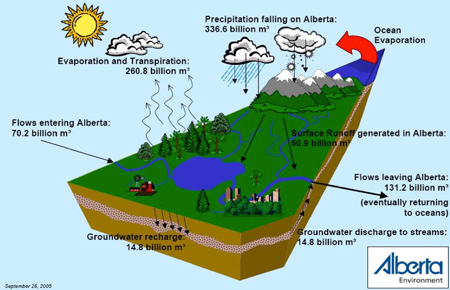What do we know about Groundwater Today?
What do we know about Groundwater Today?
Water Balance
According to the Merriam-Webster dictionary, the term “balance” refers to:
- an equality between the totals of two sides of an equation
- a physical equilibrium between the components of a system
When operating under the principle of sustainability, consideration is given to the interactions of competing system components and the management of those components to maintain a suitable balance so as not to adversely affect the system. With respect to water, this relates to a balancing between supply and demand and an acknowledgement and understanding of the external forces that can affect the supply side of the equation (e.g., climate variability or change).
Alberta’s Water Balance

The most current water balance for the province of Alberta was generated in 2005 by the Government of Alberta. The diagram shows the results of this water balance, indicating the major inflows (precipitation, runoff and surface water flows entering the province) and outflows (evaporation and transpiration, flow leaving the province).
Of the water that is received in our province, the recharge to the subsurface was estimated at the time as 14.8 billion cubic metres (m3). For context, this amounts to the volume of about 5.9 million standard Olympic-sized swimming pools each year (50m long x 25 m wide x 2 m deep). Additionally, all 14.8 billion m3 of recharge was interpreted to discharge to the various rivers and streams as baseflow contribution.
Updates to this estimate of groundwater recharge have been made since the 2005 figure. The new paradigm presented in this study, is that some of the recharge to the subsurface environment actually becomes part of a stored volume of water that exists in various locations within the overall groundwater system of the province. It is this recharge that is responsible for the increase in water levels measured in water wells and observations wells across Alberta.
In contrast, the drainage of this recharged water to surface water feature, such as lakes, wetlands, streams and rivers, in combination with the variable influx of precipitation due to changing climatic conditions is responsible for declining water levels noted in some of these same wells.
As a result, the balance of recharge and discharge is reflected in the amount of stored groundwater held beneath the province at any given time.
